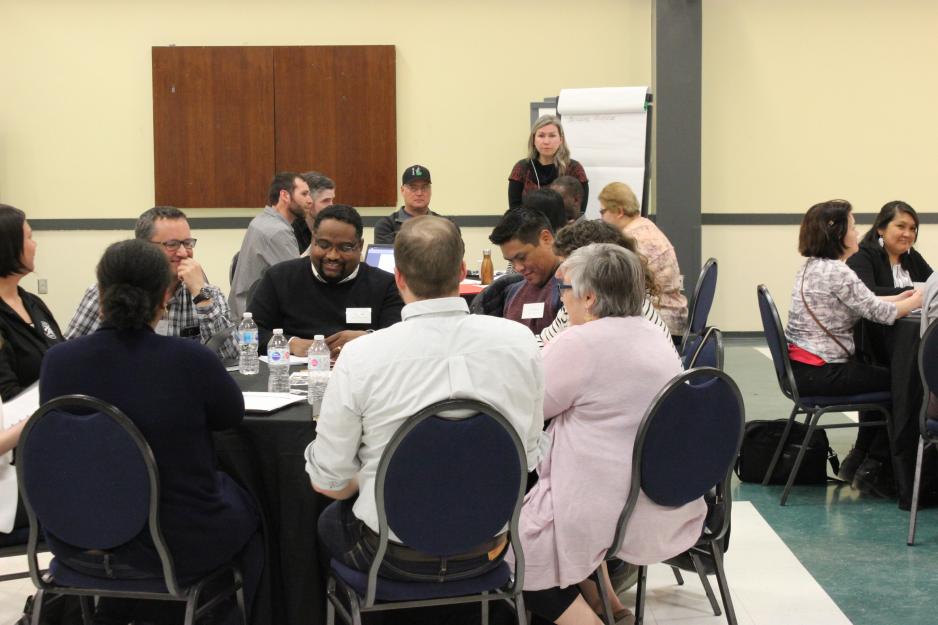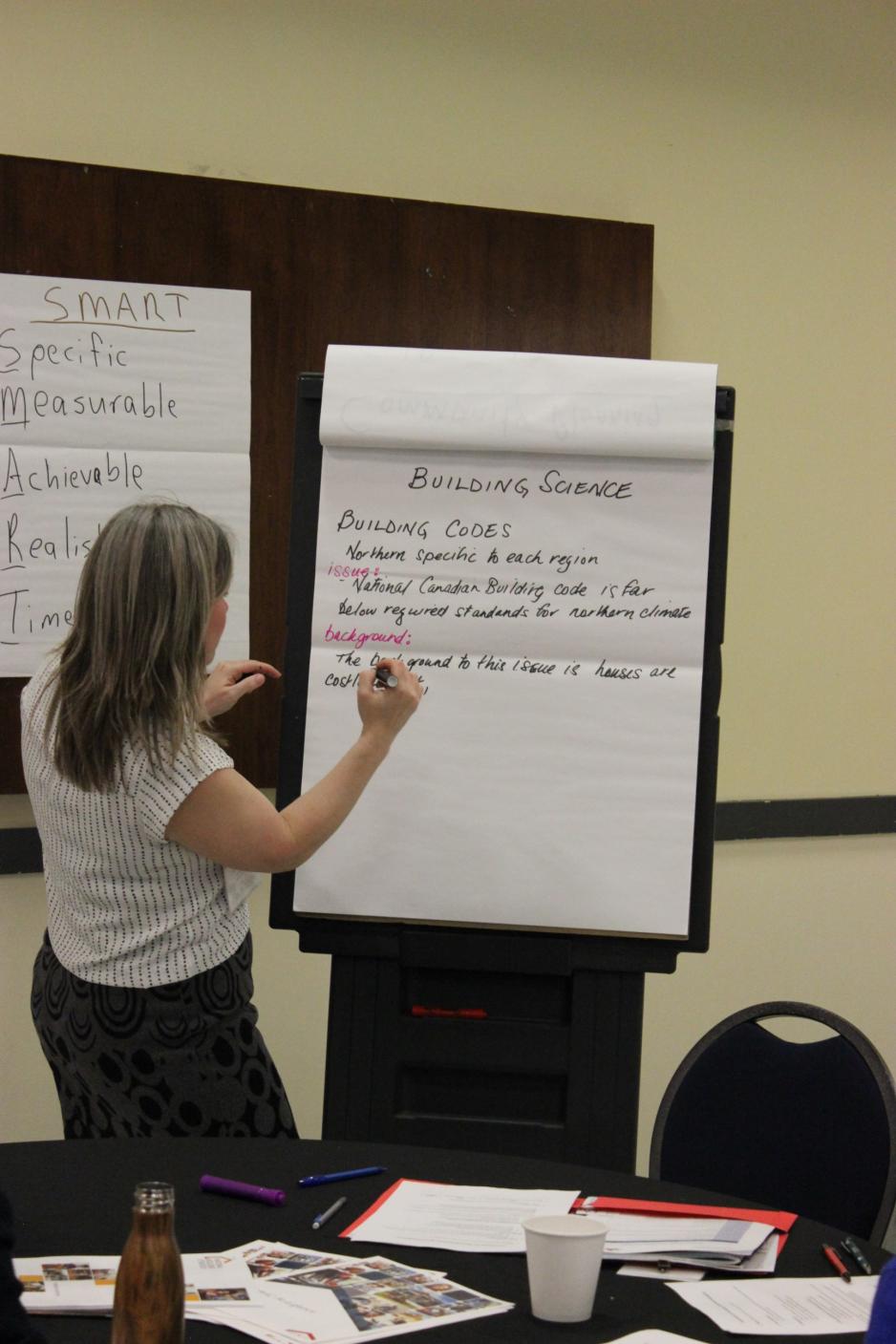Tackling the Housing Crisis in Northern Canada

Participants from across the three territories and Inuit Nunagat came together in Inuvik to discuss northern housing policy (Photo credit: The Gordon Foundation)
Housing is not only a housing issue—this is the starting premise of a report released earlier this month. Several recommendations in the report targeted the Canada Mortgage and Housing Corporation (CMHC).
The result of the third Northern Policy Hackathon, the report details recommendations compiled over a weekend of workshops in Inuvik, Northwest Territories. It highlights that northern communities currently face housing shortages, limited private markets, inconsistent housing quality, culturally inappropriate homes, a lack of community housing, as well as high construction and maintenance costs.
Beyond simply a question of housing, however, the report acknowledges significant social, economic, environmental, and health consequences that are created or exacerbated by the acute housing problems facing northern communities.
Health and housing: the case of mold
The link between housing and health outcomes made national headlines earlier this year when Cat Lake First Nation, a community in northern Ontario, declared a state of emergency due to a severe problem with mold infested homes.
One woman was also believed to have died due to health complications originating with the mold in her home and independent contractors deemed that 87 houses in the community were uninhabitable.
Issues with mold are not new to remote and rural northern communities, however. In 2017 it was found, for example, that 116 units owned by the Nunavut Housing Corporation would have to be cleaned by contractors with hazmat gear due to the severity of the mold infection.
Reporting on the incident noted that overcrowding due to a housing shortage was also a contributing factor.
Solutions for the North, by the North
The recently released report sponsored by the Gordon Foundation notes that many of these problems stem from housing policies created and implemented by previous federal governments that did not always consult adequately with northerners.
Attempting to rectify this, the solutions proposed at the third Northern Policy Hackathon were forwarded by those living in the North, for those living in the North.
Following on the success of the first and second policy hackathons—on food insecurity and business development respectively—participants came from across the Yukon, Northwest Territories, Nunavut, and Inuit Nunangat.

The main themes discussed were Community-Driven Development, Building Science, Financing, Integrating Housing Supports (Photo credit: The Gordon Foundation)
Participants included a broad swathe of community members ranging from landlords to Gwich’in elders, civil society organisations, academic institutions, and all levels of government.
Northern appropriate solutions
One major problem facing northern communities highlighted by the report is that the National Canadian Building Codes are far below sufficient for building in norther climates. Furthermore, industry best practices used elsewhere in Canada are not always appropriate or adequate to meet the challenges of building in the North.
As a result, the report recommends the creation of a pan-northern public information and research hub to support the creation of northern best practices. This would be accompanied by the development of Model Building Codes that better suit the climactic conditions faced in the region.
Not only are building designs not suitable for the climactic conditions faced, they are often culturally inappropriate or do not meet the needs of the community. Participants, as a result, noted in the report the need for any future housing strategies to be developed from the community level up and with long-term and flexible funding options.
Financing challenges
Although the Canadian government has announced $600 million for on-reserve First Nations housing, $500 million for Métis housing, and $400 million for housing in Inuit Nunangat, funding gaps remain.
It is not one size fits all. However, the duty to consult and direct, flexible funding will ensure a successful outcome
Some First Nations and Inuit in the northern extent of other Canadian provinces—as well as in parts of Canada’s three northern territories—did not receive direct funding, for example. To tackle this, the report argues for a direct and flexible funding system to be put in place by 2025.
Flexibility is particularly important, notes Jason Snaggs, one of the participants that contributed to the report. “It is not one size fits all. However, the duty to consult and direct, flexible funding will ensure a successful outcome.”
Making the Canada Mortgage and Housing Corporation work for the North
Several recommendations in the report targeted the Canada Mortgage and Housing Corporation (CMHC).
In order to address the lack of interest by the private and commercial banking sector in the North, the report recommends that CMHC be tasked to provide assistance on a sliding scale to northerners. This would encompass everything from mortgage loan insurance and to home related inspections.
Other proposals to reform the CHMC to better meet the needs of northerners involved revising their funding formulas to reflect the reality of housing in the North.Some ways this could be done include producing information catered to northerners, streamlining application processes, and providing CHMC personnel on the ground.
Integrated housing
Given the dire state of public housing in the North, the report also highlights the need for a systemic overhaul of social housing in the region that is based on community needs. The recommendations call for the creation of a new housing paradigm based on the principles of the Truth and Reconciliation Commission’s Calls to Action.
This would involve not only building partnerships with communities, but also reconfiguring federal housing programs to be culturally safe and include wrap-around services ranging from healers to social workers.
As one participant, Nelson Lepine, neatly summarized: “The focus is people, the by-product is housing.”
